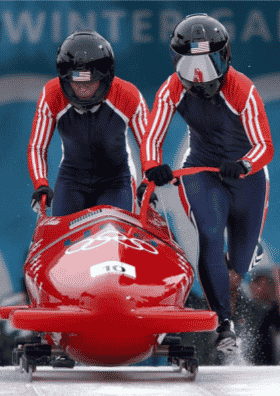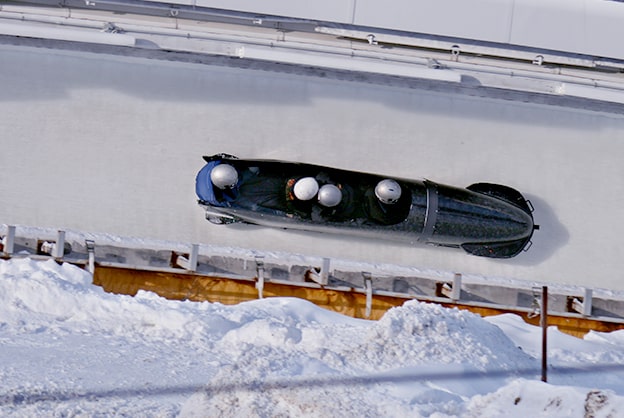Overview
STEM careers
Time
Materials
Supplies & Equipment:
|
Consumables:
|
Relevant Terminology
Center of mass: The point in an object around which the mass is balanced. If you were to balance the bobsled on your finger, that point is the balance point, which isn’t always right in the middle.
Drag: The slowing down of something as it moves through air, water, or other fluid, which causes friction. A race car experiences drag because of air pushing against it as it goes around the track.
Friction: The force that slows objects down when they are rubbing against each other. Some things make lots of friction, like brakes on a tire, and some make very little friction, like skates on ice.
Kinetic energy: Energy of motion. A bobsled sliding down its track has kinetic energy.
Momentum: The amount of mass in motion. An object’s momentum depends on how much matter (its mass) is moving and how fast it’s moving. A boulder speeding down a mountain has much more momentum than a marble rolling slowly across the floor, and would require much more energy to stop it. (For older participants: momentum is the product of an object’s mass and its velocity.)
Potential energy: Stored energy. Anything that can move but isn’t has potential energy. A bobsled right before it starts down its racecourse has potential energy.
Introduce
GETTING READY
Set up a bobsled track with the rain gutters. You may use just one gutter or set up several for races.
- Place one end of the gutter on a table or other structure. Place the other end on the floor.
- You can set the angle of the bobsled track to any angle you like, but an angle of 45 ̊ is a good place to start.
If using hinged soap containers, consider cutting the tops off. This will allow participants to easily adjust the placement of weight inside and around the bobsled. Depending on the type of soap container you use, you might be able to make two bobsleds out of each container.
The dead batteries and binder clips will be used to add weight to the bobsleds. You can weigh them in advance and provide this data to participants, or provide a digital scale so that participants can weigh their bobsleds.
INTRODUCTION
Bobsled racing is an exciting winter sport, but it is also an exercise in science and engineering. Racers zip down an icy track, often at speeds over 90 mph (150 km/h). Ask participants:
- What is the force that makes a bobsled move? (Gravity.)
- What force works to slow down a bobsled? (Friction, drag/air resistance.)
Early bobsleds were similar to wooden sleds used by children. The pilot steers the metal runners in front, and the person in the rear operates the brakes. Credit: German Federal Archive.
Instructions
Introduce the design challenge: build a bobsled out of a soap dish that can slide down a track faster than any of the other teams’ bobsleds.
Organize participants into bobsled teams. Tell them to think about how to build the bobsled before they start construction. Ask participants to consider:
- How can you reduce the friction between the bobsled and the track?
- How much should your bobsled weigh?
- How should the weight be distributed? Will your bobsled go faster with weight toward the front, in the middle, or near the back of the bobsled?
Keep track of the total weight, the distribution of weight, and the time for each prototype.
Show teams how they can tape batteries down on the inside of the soap dish or clip binder clips on the edge to provide weight. Some teams may use the straws or pipe cleaners to make runners that lift the bobsled off the track.
Test the bobsleds. Each team should choose a person to release the bobsled at the starting line and another person to be the timer. Count down from 5 and release the bobsled. Avoid pushing the bobsleds: let gravity provide the force, which also keeps the race fair. Once all the bobsleds have been raced, ask:
- How can you modify your bobsled to get a better time? Make modifications and test again.
ACTIVITY VARIATIONS
- Experiment with the angle of the track. Which angle makes the bobsled travel fastest?
- Design a bobsled that travels the slowest but still makes it to the finish line. Design a way to make a curved track.
- Limit designs to a maximum weight.
- Calculate the slope of the track by measuring the run and the rise.
- Create a cost for each material and set a budget for each bobsled.
TROUBLESHOOTING
If the bobsled doesn’t slide, there may be too much friction. Investigate ways to reduce the friction between the bobsled and the track. Alternatively, you can increase the slope of the track.
Guiding questions
GUIDANCE FOR YOUNGER CHILDREN
QUESTIONS TO ASK AFTER THE ACTIVITY
- What happened when you added binder clips? How did you decide where to put them?
- How many batteries worked best to make the bobsled go really fast?
- What materials made the bottom of the soap dish slide better?
- If your bobsled didn’t slide straight down the chute, why not, and how did you fix it?
- Did you do anything that made the bobsled go more slowly, rather than faster? If so, what was it and how did you fix it?
GUIDANCE FOR OLDER YOUTH AND ADULTS
QUESTIONS TO ASK AFTER THE ACTIVITY
- If you had access to any materials you wanted, what would they be? Why?
- What forces were acting on your bobsled? How did your design address the effects of these forces?
- List everything that could cause issues with drag. How would you address each concern in your design?
- How might the shape of the bobsled affect its speed? What shape do you think would be the fastest?
- What additional considerations would you have to make to your design if the track were curved?
- How do you think engineers who design real bobsleds cut down on drag?
Engineering & science connections
GUIDANCE FOR YOUNGER CHILDREN
Engineering Connections

Early bobsleds were similar to wooden sleds used by children. The pilot steers the metal runners in front, and the person in the rear operates the brakes. Credit: German Federal Archive.
Bobsled engineers keep coming up with new ways to make bobsleds faster and safer. For example, bobsleds used to be made out of wood. Now they are made out of fiberglass on a steel frame, which makes them stronger and lighter. Engineers also design bobsleds for speed, which accounts for their bullet shape. After all, what’s faster than a speeding bullet?
Engineers think about safety for bobsled riders, too. They have designed tracks with high sides so that the sled stays on the track and doesn’t fly off. The walls are curved in a way that helps prevent the sled from flipping over.
Science Connections
Successful bobsledding depends on two types of forces: gravity and friction. Friction is a force produced when two objects rub against each other and is constantly working against their motion. In this case, the sled rubs against the track. Bobsled tracks are made of ice, which doesn’t produce much friction because it is so slippery. But the air around the sled also causes friction because the sled is moving so fast. You can feel this friction when wind blows into your face while you’re sledding down a hill. The design of the bobsled reduces the amount of friction from both the track and the air.
GUIDANCE FOR OLDER YOUTH AND ADULTS
Engineering Connections
While much of a bobsled team’s success depends on the skill of the riders and the precise navigation of the team’s drivers, success also depends on the engineering and design of the sled. In 2014, BMW partnered with the US Bobsled Federation to redesign the sled for better speed. BMW engineers used aerodynamics to come up with the best design. The result? In 2014, at the Sochi Winter Olympics, Team USA took home its first medal in two-man bobsledding since 1952. Aerodynamics is the study of the flow of air as it passes over and around a moving object and of the forces the air makes on an object. The BMW engineers built on their knowledge of racecar aerodynamics to finesse their bobsled designs, which included shifting the center of gravity to allow for tighter steering.
Science Connections
For one bobsled to succeed over another, it must have a higher velocity, or speed, as it goes down the hill. This means that the bobsled team must maximize the amount of force that propels the sled forward and minimize the amount of force that works against the motion of the bobsled. Without a motor to propel it forward, the sled depends on gravity to keep it moving, as well as a running push from the team at the very top of the hill. Heavier bobsleds have more potential energy, and therefore more kinetic energy when they get moving. Modern bobsledding has weight limits on the sled and riders, so it’s hard to get a weight advantage today. The key to winning is to overcome the forces that would otherwise decrease the bobsled’s velocity, such as friction and drag.
Activity created by Museum of Science, Boston. All rights reserved.
http://legacy.mos.org/designchallenges/challenge.php?dc=bobsleds
Supplemental content adapted for Dream Big Activities by the Carnegie Science Center.


0 Comments